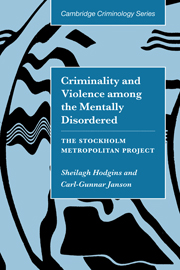Book contents
- Frontmatter
- Contents
- List of figures
- List of tables
- Preface
- Introduction
- Chapter 1 Research on the criminality and violence of the mentally ill
- Chapter 2 The longitudinal approach
- Chapter 3 Swedish society and Stockholm: the cohort and its context
- Chapter 4 Criminality
- Chapter 5 Explanations of the criminality of the mentally ill
- Chapter 6 Early and late-starters
- Chapter 7 Conclusion
- References
- Index
Chapter 5 - Explanations of the criminality of the mentally ill
Published online by Cambridge University Press: 22 September 2009
- Frontmatter
- Contents
- List of figures
- List of tables
- Preface
- Introduction
- Chapter 1 Research on the criminality and violence of the mentally ill
- Chapter 2 The longitudinal approach
- Chapter 3 Swedish society and Stockholm: the cohort and its context
- Chapter 4 Criminality
- Chapter 5 Explanations of the criminality of the mentally ill
- Chapter 6 Early and late-starters
- Chapter 7 Conclusion
- References
- Index
Summary
HYPOTHESES
This chapter critically reviews explanations of the criminality and violence perpetrated by persons suffering from major mental disorders. Three principal hypotheses are examined.
Hypothesis 1: facilitated arrest and conviction
Persons suffering from major mental disorders are not more likely to commit crimes than persons without these disorders. However, they are more likely to be detected by the police and successfully prosecuted. Consequently, studies find that greater proportions of persons with major disorders than persons without these disorders are convicted of crimes. It is further hypothesised that facilitated detection and successful prosecution of persons with major mental disorders also explains why offenders with these disorders accumulate, on average, more convictions than do offenders without these disorders.
Hypothesis 2: inadequate and inappropriate treatment
The implementation of the policy of deinstitutionalisation in the mental health field has led to a situation in which many persons with major mental disorders receive no treatment or inadequate and/or inappropriate treatment. This lack of care is associated with the commission of illegal acts.
(2a) It is further hypothesised that because of this lack of adequate and appropriate treatment, persons with major mental disorders become symptomatic while living in the community. The development of psychotic symptoms generally but especially threat-control-override (TCO) symptoms is associated with aggressive behaviour.
(2b) The lack of adequate and appropriate treatment has also created a context in which many persons with major mental disorders are using and abusing alcohol and drugs. Substance abuse is associated with criminal activity.
- Type
- Chapter
- Information
- Criminality and Violence among the Mentally DisorderedThe Stockholm Metropolitan Project, pp. 108 - 140Publisher: Cambridge University PressPrint publication year: 2002
- 1
- Cited by

